WiMAX today
Despite the all-round occurrence of the WiMAX still in the design even in the most developed countries, introduction of the standard is progressing at an enviable pace. Quite recently, last autumn during the days of Intel Developers' Forum in the building of Russian Academy of Sciences the experimental network IEEE802.16-2004 was demonstrated in action. And last week in Kiev, Ukraine, Ukrainian advanced technologies commissioned the first in the ex-USSR network of wireless broadband access to Internet on the base of the WiMAX technology. From that week onwards, the network by "Ukrainian Advanced Technologies" dubbed ALTERNET started rendering services of wireless broadband access to Internet on the base of WiMAX using client devices built on the Intel PRO/Wireless 5116 chipset.
The services are about fixed wireless access to Internet using the WiMAX technology based on the Alvarion client equipment built on the Intel PRO/Wireless 5116 chipset. They are offered to companies and private persons who are based in the areas of poorly developed or outdated cable infrastructure. "Ukrainian Advanced Technologies" intends to provide its services on a turn-key basis in merely two days after the first customer's call. Today, you can subscribe to the services in Kiev and Kharkov. There are plans for the first quarter of the next year to establish regional offices to render the access services in Dnepropetrovsk, Odessa, Donetsk, and Lvov. On the whole, it is planned to provide WiMAX connection facilities in all the regional centers of Ukraine by the end of 2006.
In fact, you shouldn't think that some sort of a WiMAX anomaly is going on in the Ukraine. Introduction of WiMAX networks is going on continuously these days, announcements of launching such networks are appearing every day, and only in Russia this issue is being solved extremely slowly (read below).
Modern hardware for WiMAX
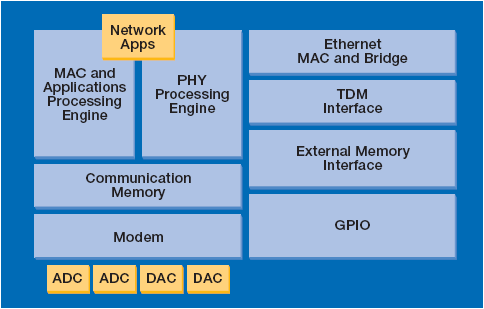
As regards the capabilities of PRO/Wireless 5116 chipset officially presented by Intel in April 2005, it proved to be one of the first products in the industry with support for the WiMAX standard. This Intel chipset is made in a 360-pin PBGA casing, offers functionality needed to implement establish economical high-speed wireless modems for the home and office. Solutions based on PRO/Wireless 5116 allow providing broadband access to the Internet in remote areas where no DSL or cable networks are there and establish communication between tasks distributed a few miles apart.
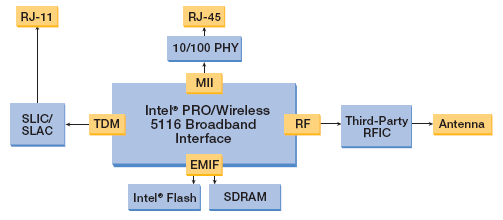
Combined with a RF module and a third-party amplifier, the SoC system Intel PRO/Wireless 5116 with support for IEEE 802.16-2004, formerly known as the Rosedale, provides the possibility to use WiMAX networks for a wide circle of users.. At the same time, the Intel PRO/Wireless 5116 interface supports not only external but internal solutions, e.g. WiMAX subscriber modems and home-based gateways.
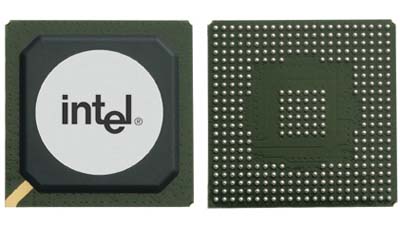
Intel PRO/Wireless 5116 (Rosedale)
WiMAX Forum. Intel's role in establishing the standard
For the purposes of testing, standardization, certification and marketing of WiMAX products, the WiMAX Forum industry alliance has been established. It's just this alliance that issues "WiMAX Forum Certified" verdicts. By now, the number of WiMAX Forum members is rapidly approaching to 200, and over one quarter of the number are operators who are rendering provider services based on the WiMAX technology.
Once of the most active member of the WiMAX Forum alliance is Intel who participates in all the undertakings – from problem statement up to the ratification of standards and development of end equipment. Intel is now cooperating with companies who have deployed pre-standardized WiMAX broadband wireless networks in over than 125 countries. They offer a wide range of options - from stationary systems of wireless access up to enterprise-scale point-to-point data transmission systems.
For the purposes of testing, standardization, certification and marketing of WiMAX products, the WiMAX Forum industry alliance has been established. It's just this alliance that issues "WiMAX Forum Certified" verdicts. By now, the number of WiMAX Forum members is rapidly approaching to 200, and over one quarter of the number are operators who are rendering provider services based on the WiMAX technology. Apart from Intel Corporation, other known companies participate in the WiMAX Forum, among them Airspan Networks, Alvarion, Aperto Networks, Ensemble Communications, Fujitsu Microelectronics America, Nokia, OFDM Forum, Proxim Corporation, Wi-LAN Inc. and others.
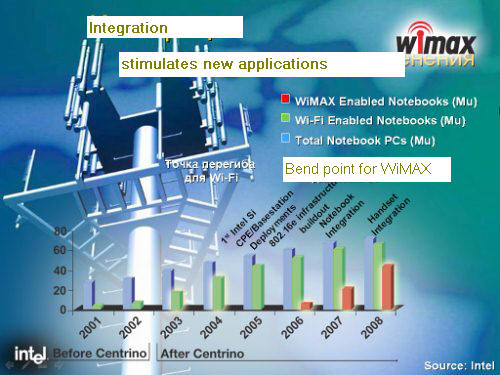
One of the most active member of the WiMAX Forum alliance is Intel who participates in all the undertakings – from problem statement up to the ratification of standards and development of end equipment. Intel is now cooperating with companies who have deployed pre-standardized WiMAX broadband wireless networks in over than 125 countries. They offer a wide range of options - from stationary systems of wireless access up to enterprise-scale point-to-point data transmission systems.
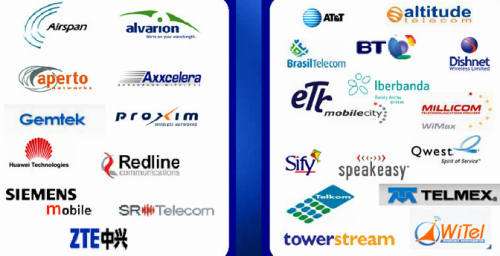
Among the operators collaborating with Intel at the promoting of WiMAX solutions are AT&T (USA), Altitude Telecom (France), BT (U.K.), Brazil Telecom (Brazil), ETB (Columbia), Iberbanda (Spain), Millicom (Argentina), Qwest (USA), Sify (India), Speakeasy (USA), Telkom (South Africa), Telmex (Mexico), TowerStream (USA), and the already mentioned "Ukrainian Advanced Technologies" (Ukraine). The release of produce manufactured on the base of Intel PRO/Wireless 5116 has been announced by Airspan, Alvarion, Aperto Networks, Axxcelera Broadband Wireless, Gemtek, Huawei, Proxim Corporation, Redline Communications, Siemens Mobile, SR Telecom, and ZTE.
Remarkably, these days Motorola and Intel announced their joint plans for promoting the IEEE 802.16e-based WiMAX technology for mobile solutions and which is applicable to both stationary and wireless devices fir broadband communications. Apart from promoting the WiMAX standards, the joint plans of these companies include tests of mobile devices, networked and subscriber end equipment made by Motorola for compatibility to Intel's produce.
WiMAX in Russia
Late in October, the first in Russia seminar on using the WiMAX arranged by Intel was held in Nizhny Novgorod. The seminar gathered representatives, telecommunication companies, providers, developers and manufacturers of wireless communications equipment, as well as government institutions in charge of frequency regulations and licensing. During the event, Intel representatives demonstrated a model of operating network built on the base of the Intel Pro/Wireless 5116 chipset.
Alas - not all are as enthusiastic as Intel. As regards the real dates for introduction of a new backbone wireless standard in Russia, many analysts agree that formation of WiMAX networks in Russia will not start earlier than the summer of 2006. Many pledge to the incomplete certification for WiMAX equipment, many complain about the high price of first-generation WiMAX solutions, but in general there is a lack of intention from the side of providers to spend for a technology which is unlikely to pay back soon. In large cities where there are still more than enough facilities for fast-speed Internet access, the Wi-Fi capacity is still enough. As regards deployment of WiMAX networks somewhere in remote areas in Russia, no one is yet planning to do so at the first stage. Of course, there will be isolated instances of WiMAX network deployment, but we won't hear about them in the near future. But while there is little interest from administrative bodies and lack funding all these events will still be unique.
In a word, many agree that WiMAX networks are unlikely to go beyond the boundaries of large Russian cities earlier than 2009. At the same time, in the Net you can find a variety of contrary opinions stating that if introduction of WiMAX networks at the first stage proves successful, their number may go up as a snowball within short terms.
Perhaps I'd rather stop my today's story at the note of uncertainty. Early in 2006, the WiMAX standard is in for another epochal event and we'll hope that by that time the news on Russian market of WiMAX networks will be more optimistic.
